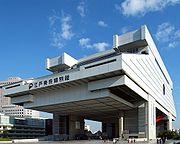
Kiyonori Kikutake
Encyclopedia

Japanese people
The are an ethnic group originating in the Japanese archipelago and are the predominant ethnic group of Japan. Worldwide, approximately 130 million people are of Japanese descent; of these, approximately 127 million are residents of Japan. People of Japanese ancestry who live in other countries...
architect
Architect
An architect is a person trained in the planning, design and oversight of the construction of buildings. To practice architecture means to offer or render services in connection with the design and construction of a building, or group of buildings and the space within the site surrounding the...
known as one of the founders of the Japanese Metabolist group. He has also been the tutor and employer of several important Japanese architects, such as Toyo Ito
Toyo Ito
is a Japanese architect known for creating conceptual architecture, in which he seeks to simultaneously express the physical and virtual worlds. He is a leading exponent of architecture that addresses the contemporary notion of a "simulated" city, and has been called "one of the world's most...
and Itsuko Hasegawa
Itsuko Hasegawa
is a noted Japanese architect.-Biography:Hasegawa was born in Shizuoka, received her degree in architecture from Kanto Gakuin University , trained with Kiyonori Kikutake. In 1969, Hasegawa entered Kazuo Shinohara’s lab at the Tokyo Institute of Technology as a graduate student...
.
Career
Kikutake is most well known for his "Marine City" project of 1958, which formed part of the Metabolist Manifesto launched at the World Design Conference in Tokyo in 1960 under the leadership of Kenzo TangeKenzo Tange
was a Japanese architect, and winner of the 1987 Pritzker Prize for architecture. He was one of the most significant architects of the 20th century, combining traditional Japanese styles with modernism, and designed major buildings on five continents. Tange was also an influential protagonist of...
. He, along with fellow member Kisho Kurokawa was invited to exhibit work at the "Visionary Architecture" exhibition in New York of 1961, through which the Metabolists gained international recognition. Kikutake has continued his practice to this day, producing several key public buildings throughout Japan, as well as lecturing internationally. He is also the former President and current Honorary President of the Japan Federation of Architects & Building Engineers Association.
Awards
Kikutake has been the recipient of numerous awards both in his native Japan and internationally. These include the Japan Academy of Architecture Prize (1970) and the UIA (Union International des Architects) Auguste Perret Award (1978).List of works
- Marine City, 1958
- Tatebayashi Civic Centre, 1963
- Matsumi Tower, 1976
- Edo-Tokyo MuseumEdo-Tokyo MuseumThe is a museum of the history of Tokyo, established in 1993. The main features of the permanent exhibitions are the life-size replica of the Nihonbashi, which was the bridge leading into Edo; the Nakamuraza theatre; scale models of town; and buildings from the Edo, Meiji and Shōwa periods.The...
, 1993 - Showa Kan, 1999

